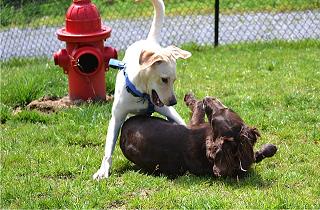 You love your dog. He’s your loyal confidant, your tireless travel buddy, and your four-legged family member. But when it comes to his play time, do you love him a little too much?
You love your dog. He’s your loyal confidant, your tireless travel buddy, and your four-legged family member. But when it comes to his play time, do you love him a little too much?
Just as with human children, we want the best for our canine kids. And just like overprotective human parents, we can sometimes be guilty of hovering over our dogs as they play (especially if they are little guys or gals). While helicopter pet parents mean well, they aren’t actually doing what’s best for their dog. In fact, the results can be detrimental—and in some cases dangerous—for their furry charges.
Expert dog trainer and animal behaviorist Elsa Larsen of My Wonderful Dog notes that while protective behaviors like discouraging socialization, keeping a dog tightly controlled on a leash, or picking up or carrying a dog can be very appropriate responses in some situations, when taken to extremes or done at inappropriate times, they can set your dog up for fear, aggression and other antisocial behaviors.
While keeping your dog firmly leashed in public places and during walks is a smart thing to do, holding him protectively close during greeting or play can backfire. This is especially true at dog parks, where there are often many off-leash dogs around. “Dogs have an instinctive ‘fight-or-flight’ response to threatening situations,” Elsa notes. “If you have your dog on a leash, and all of a sudden he’s surrounded by a bunch of dogs off leash, he may act defensive because his opportunity to flee has been taken away.”
Picking your dog up to avoid imminent danger is always prudent. Doing so because he seems uncomfortable or fearful could be a mistake. Elsa explains that if your dog is a resource guarder, he could very well see you as one of his most important resources. Holding him in your arms when you’re around other dogs may exacerbate his guarding problem and cause him to behave aggressively.
While carrying your small dog everywhere may seem like a protective and kind gesture, it can do more harm than good in the end. “I call it Little Dog Syndrome,” Elsa explains. “Pet parents don’t feel comfortable with their little dog navigating through the world on their own four feet. Carrying your dog everywhere does him a great disservice because he doesn’t get a chance to be a dog. You may in fact be creating a dog who’s antisocial and doesn’t have good skills meeting and greeting other dogs.”
So how do you know when to step in and when to just let your dog meet, greet, and play? Elsa stresses that there’s no one-fits-all answer, and that every dog and every situation is different. But she does have some tips that will help you keep your pup happy during playtime.
- Whenever possible, allow your dog to greet and play with other dogs off leash. This will give him confidence to know that he can run if he has to. If he feels threatened but can’t run, his only option will be to fight.
- Periodically break up the play. This will prevent fatigue and overexcitement. Elsa notes that if you remove your dog briefly from his play session for a rest and he wants to return, it’s a sign that he’s having fun and feeling confident.
- Watch all the dogs involved for signs of overexcitement, such as excessive barking, sneezing, rough play, bullying behaviors, or any kind of challenging postures. If your dog is being threatened or challenged, or he always seems to end up on the bottom of the pack, remove him from the situation.
If you give your furry friend some freedom to be himself and face challenges on his own, you’ll be rewarded with a dog that’s more confident, friendlier, and happier. So park the helicopter, and let your dog out to play!